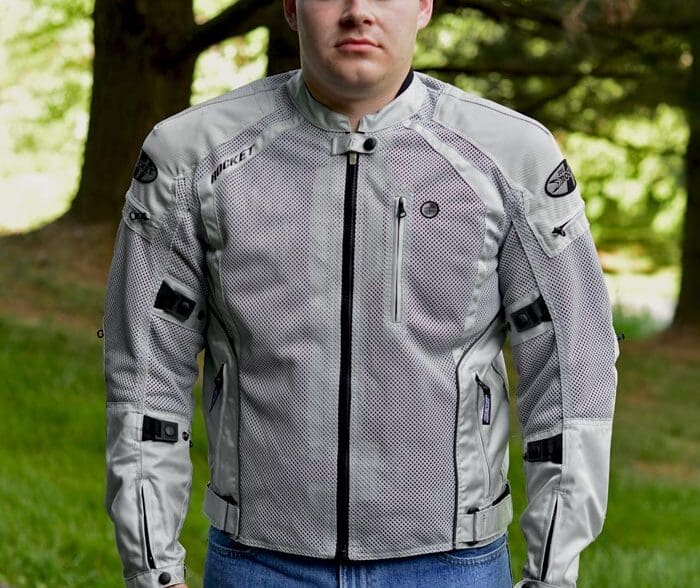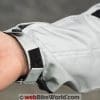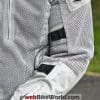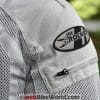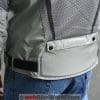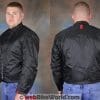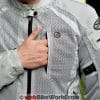The Joe Rocket Phoenix Ion Jacket is a variant of the long-running and ever-popular Joe Rocket Phoenix mesh jacket (review).
Our feeling is that there’s not all that much difference between the standard Phoenix jacket and the Phoenix Ion version.
There is one thing though: the “INNOLITE” reflective coating on the Ion version of the jacket.
Joe Rocket has been promoting this feature as one of the main selling points for the Ion jacket, but the ads are misleading, in our opinion.
First of all, the INNOLITE reflective weave is actually in the shoulders only, not the entire jacket.
Also, the INNOLITE reflective material doesn’t seem much different than the other “dotted” reflective weave we have seen before, which for the most part we have not found to be very effective.
Some of the photos used in the Joe Rocket advertisements make it look like the entire jacket “glows” at night when illuminated; in fact, that’s what we thought and it’s pretty much the main reason we purchased this jacket.
But in fact, our experience is that the Ion jacket has very poor reflectivity, on the road or in the photo studio.
Both the INNOLITE shoulders and the reflective striping and piping on other parts of the jacket have negligible reflective properties on our jacket.
Indeed, the Phoenix Ion jacket may have less reflectivity than many other summer motorcycle jackets we have reviewed.
We’ll focus on this issue in this review, with many photos below, illustrating our attempts to get the jacket to reflect and a couple of comparison photos comparing reflectivity with a cheap generic reflective safety vest.
The poor performance of the INNOLITE and the weak-to-no reflectivity of the jacket overall is a big disappointment, especially since that is a major selling point of the Phoenix Ion jacket.
So you may want to save yourself the $20.00 and get the basic Phoenix jacket — still in version 5.0 — instead.
There isn’t all that much difference between the two anyway, unless you count the lightweight zip-in insulating vest in the Phoenix Ion that you probably don’t need anyway (along with the “waterproof” removable shell).
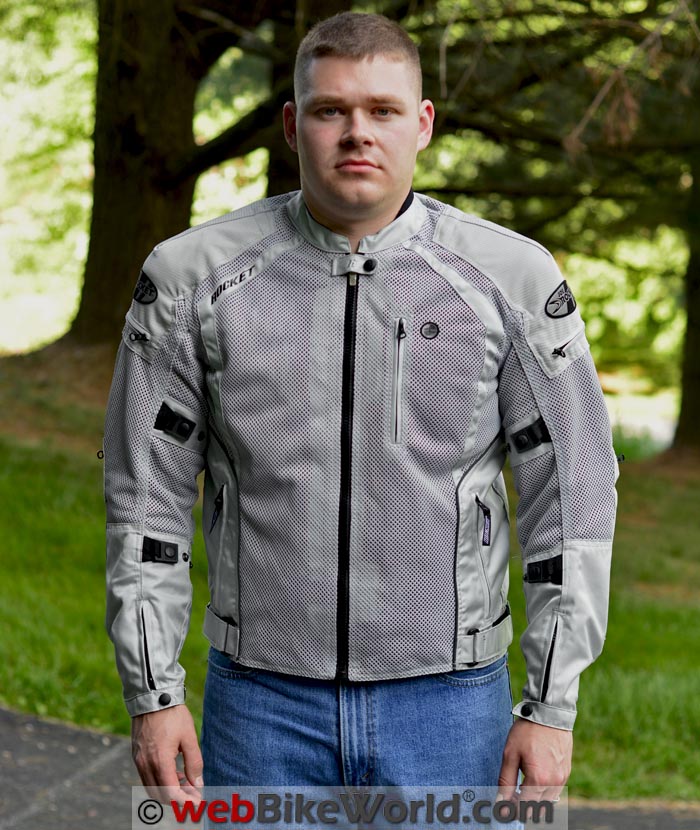
Fit and Sizing
This Phoenix Ion jacket is a men’s size large and it fits as expected for about a 43″ to 44″ chest.
The sleeves are proportional and the lining on the inside of the sleeves is slightly baggy, making it a bit fussy to get your arms in or out in hot and sweaty conditions.
For adjustment, a wide band of hook-and-loop on each side at the hem can be used to tighten the waist.
Each sleeve has a three-position snap adjuster at the forearm and bicep. Like every other Joe Rocket jacket that has come through here, the snaps don’t always hold tight.
We both needed the third position to snug the arms tightly enough to hold the elbow protector in place, but since the snaps can pop loose, it makes one wonder whether they will hold the protectors in place during a crash.
A strip of hook-and-loop through a D-ring might be better.
Tightening the arms using the snap adjusters means there’s some extra material on the inside of the arm, which more or less can be folded under so that you don’t look like the sleeves are a couple of sizes too big and strapped down to fit.
Overall, the sizing — at least for this one example in size large — is accurate. The fit is classic Joe Rocket Phoenix; slightly baggy and in need of just a touch more tailoring and shape, as you can see in the next photo:
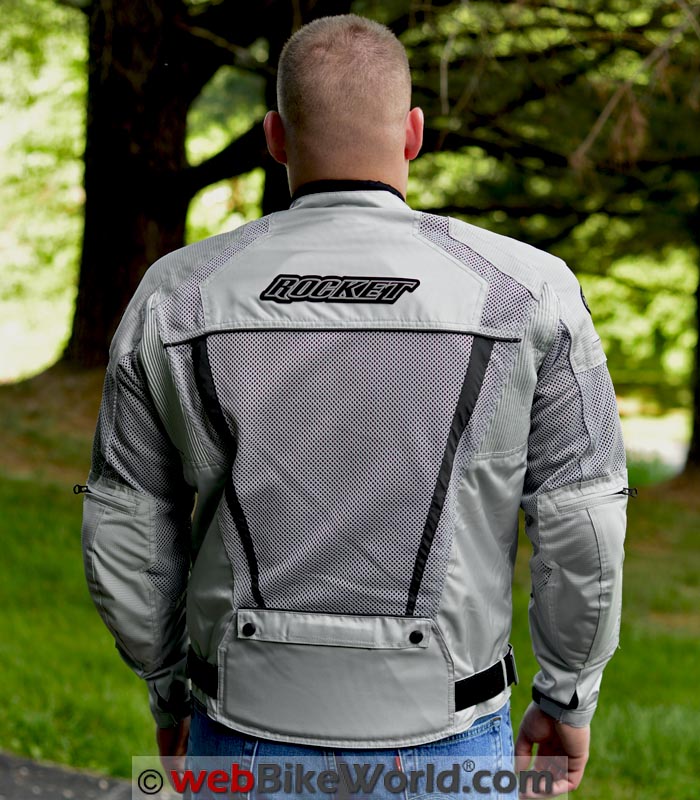
Details
If you know the Joe Rocket Phoenix mesh jacket (review), now in its 5th generation, you pretty much know the Phoenix Ion jacket in its first.
The Phoenix jacket was one of the first textile mesh motorcycle jackets produced and it became very popular. Back in 2002, when it was introduced, it was all about the ventilation. The jacket did not have a liner and didn’t need one. Pure mesh lets all the air flow right on through.
The Phoenix jacket has been updated over the years, and not always for the better. We still think the original Phoenix jacket concept was best: pure, unadulterated ventilation with some padding for modest protection.
That jacket was designed for wear in the hottest conditions, wearing just a T-shirt underneath.
The Phoenix Ion is similar to the 5th gen Phoenix jacket we reviewed in 2012. The basic concept is still there, but Joe Rocket has added some areas of “Dynax” solid fabric on the shoulders, elbows, either side at the waist or ribs and wrapped around the forearm.
Whether the Dynax is any more abrasion-resistant than the mesh is unknown to anyone, but it does block more of the air than the original pure mesh Phoenix jacket.
The stitching on our example is a bit suspect also. There are several loose stitched sections with hanging threads and very little reinforcement via bar tacking and the double rows of external stitches just don’t give an overall impression of sturdiness.
All of this means that the Ion version of the Phoenix jacket is something of a compromise.
Throw in the claimed waterproof shell liner and detachable (zippers) thin insulated vest and you end up with a bit of a mishmosh of a jacket that tries to be all things to all people but — as often happens — doesn’t have any single distinguishing characteristic.
But, the price is right, so first thing we did was remove the liner and toss it in the side case. Maybe it will come in handy for that time when you’re caught out at night and cool/damp air has replaced the hot sun of daytime.
More Details
Since the Ion is basically a tarted-up Phoenix jacket, most of the other details will sound familiar.
Pockets
Two zippered unlined hand pockets at the bottom front are handy and the zippers open from top to bottom; that is, slide the zipper down to open the pocket. This helps when you want to grab something from the pocket but don’t want to take off your gloves.
There are two lined semi-waterproof pockets on the upper left; one is external with a zipper (and has an earphone pass-through) and the other is hidden in the placket under a black strip of hook-and-loop.
The latter might actually be a good place to store some folding money, because pretty much no one except you will know that strip of black covers a pocket! Both are handy, but the solid liners block more air coming through.
There’s a smallish pocket in the rear of the jacket, with an odd “upside down” shape. It measures about 27 cm across and 16 cm deep. The flap across the top is held by hook-and-loop and two metal snaps.
This pocket is backed by a think piece of foam rubber, apparently designed to help protect the rider from injury should there be something in the pocket if the wearer falls backwards.
Also, there’s a handy key hook inside the right placket.
Collar
The collar is non-adjustable, with just a single non-adjustable snap at the top to hold the neck closed. The collar is lined with a very soft micro-fleece.
Cuffs
The cuffs have the type of slightly too complicated dual adjusters we’re not fond of. A strip of hook-and-loop adjusts the cuff diameter, while the zipper is used to open and close the sleeve end. A snap then shuts the cuff closed after the zipper is secured.
All of this seems more complicated than just a fabric dart and a slap of hook-and-loop would be.
Zippers
The main zipper is a heavy-duty nylon toothed type with a plastic Joe Rocket branded runner. The pocket zippers have a smaller gauge but similar construction. All are unbranded.
Protectors
The protectors are basic rubbery/plastic types, claimed to be CE approved but, as smart webBikeWorlders know, without the official documentation showing test results and certified lab name, protectors are not officially CE approved.
The Ion jacket doesn’t have the correct documentation but we don’t know if Joe Rocket can certify that the protectors are CE approved.
Be sure to read the webBikeWorld Report “CE ‘Certified’ vs. ‘Approved’? There Is a Difference“for more information.
The protectors in the Phoenix Ion jacket are removable via an external zipper for the elbows and shoulders. The jacket has a foam pad for a back protector and optional back protectors may fit.
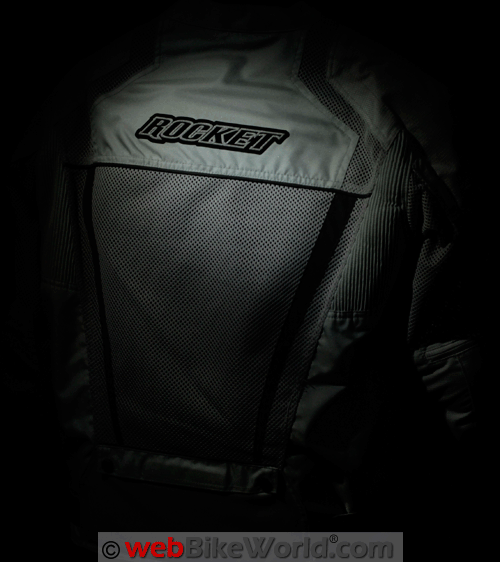
Reflectivity
So far, you might get the idea that we’re a bit underwhelmed at the Joe Rocket Phoenix Ion jacket, and that’s probably accurate.
This is your basic low-end mesh jacket with perhaps a few extra features added that don’t seem to add much over the basic version of the Phoenix jacket. But we’ll leave that up to the buyer to decide.
The one big issue we have with the jacket, however, is its lack of reflectivity. This issue is a strange one, since the manufacturer touts this as one of the jacket’s main selling points.
The very first thing we did as soon as the jacket arrived was to take it out on a night ride. We were pretty excited actually, assuming that when hit by the headlights, the jacket would light up like a firefly.
Much to our surprise, we didn’t notice much — if any — reflectivity. In fact, the jacket seems less reflective than several other basic jackets that don’t claim to have reflectivity as a main feature.
Coming back to the “lab” (i.e., the photo studio) we tried everything we could to get the jacket to light up.
Nothing worked — not a camera flash, nor a flashlight or any combination or angle thereof. Strange…
We’ve run into this before with some types of reflective material that appears similar to the “INNOLITE” textile used by Joe Rocket.
Grabbing a generic reflective safety vest off the shelf, the model held the vest near the jacket and you can see in the photos what a good reflective material should do when illuminated by a flash.
Here is an animated .gif (above) showing various angles of light at night and you can see there’s little to no reflectivity from the Phoenix Ion jacket.
And below are more still photos showing various lighting schemes. You can see once again, there is little to no reflectivity on the jacket:
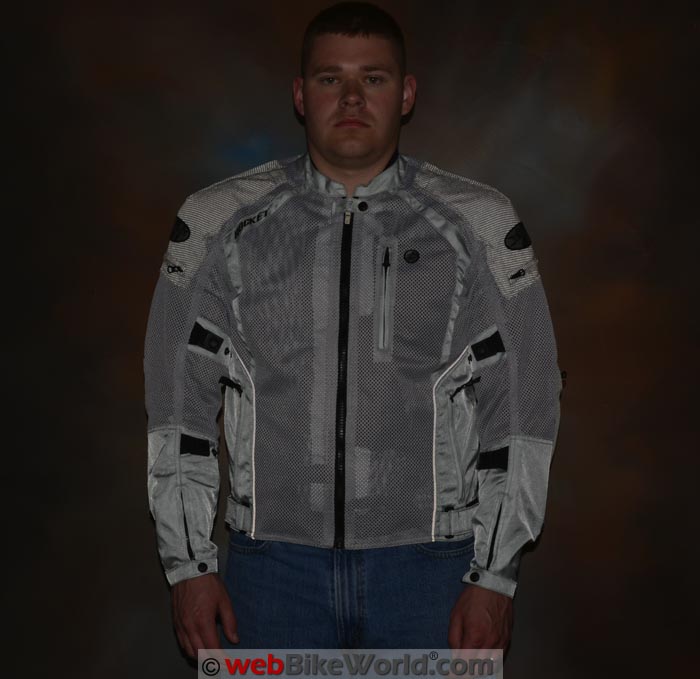


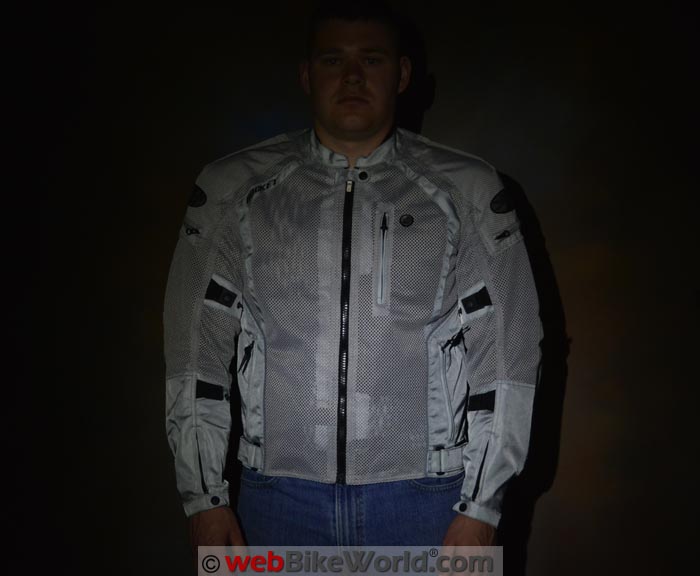


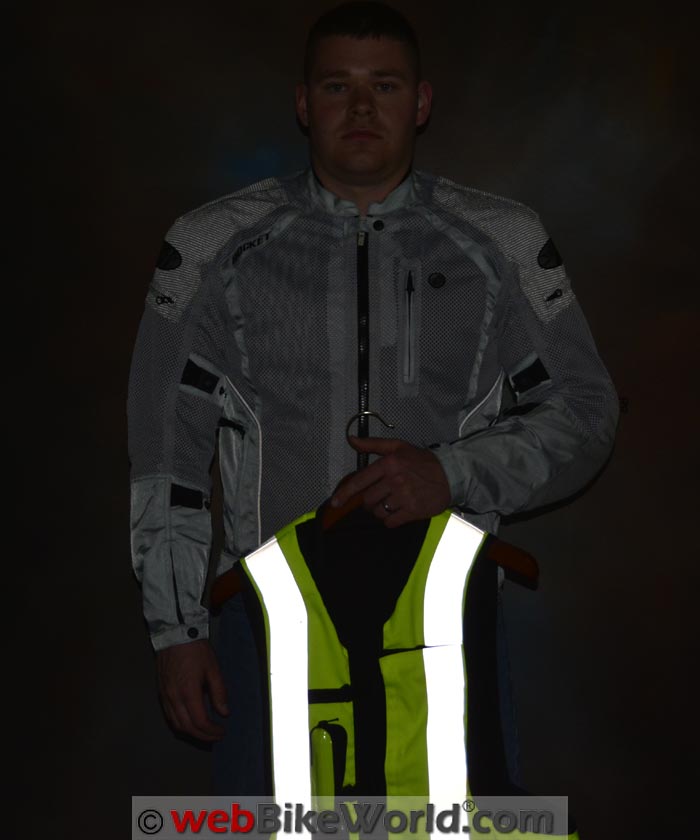


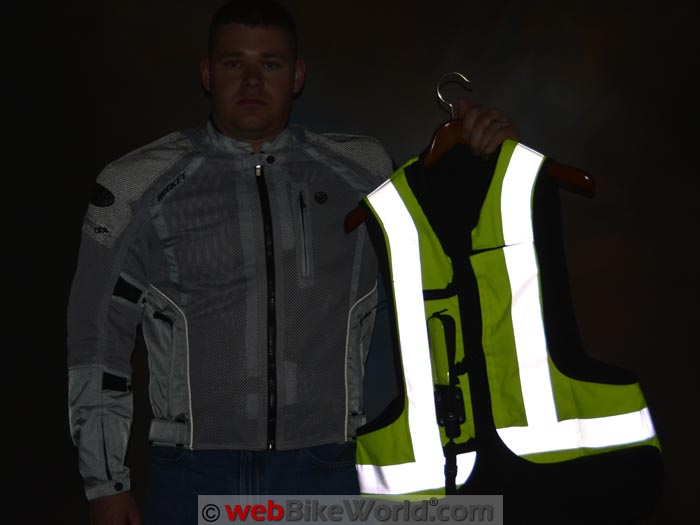


We’re not sure why our Phoenix Ion jacket doesn’t retro-reflect the way we think it should. But overall, this is a serious disappointment, after reading the Joe Rocket advertisements and seeing the photos.
Even the reflective piping on the front of the jacket and the “black” reflective strips don’t “pop” anywhere near what they should.
We’re as puzzled as you are as to what is causing this, but remember that this happened not only in the photo studio, but out on the road also when the rider was illuminated by the following vehicle.
Conclusion
Our opinion? The Joe Rocket Phoenix Ion jacket tries to be “all things to all people” and doesn’t really shine — pun intended — any anything in particular.
It’s a decent if basic mesh jacket, but when you’re buying a mesh jacket like this the primary goal is all-out ventilation.
Although the jacket does flow a lot of air, no doubt, a few of the sections of solid fabric on the shell and in the pockets do limit the amount of air that can flow through.
The puzzling lack of “pop” of the reflective material is also a big disappointment.
The original Phoenix jacket was a revelation, but unfortunately each iteration since has become less and less impressive. Perhaps it’s time for Joe Rocket to do a complete re-think of the concept.
Bottom line? Stick with the basic Joe Rocket Phoenix jacket if you’re looking for something to wear in summer.
Owner Comments and Feedback
See details on submitting comments.
From “K.D.” (July 2015): “I’ve found that the Joe Rocket line as a whole has been very disappointing the last few years. I’ve owned a number of their products throughout my riding years as they used to be a quality and affordable street riding safety apparel.
But as other manufacturers have come about with more features, better safety and greater functionality at the same price point.
I agree that Joe a Rocket needs to reevaluate and rebuild their brand to be as, or more, innovative than their competitors.”
From “C.E.” (July 2015): “I wish I had your review when before I bought one. I wore the original Phoenix for several years. The only con at the time was the jacket material was very scratchy.
The review is spot on for the newest edition. Reflectivity is weak, ventilation is less than original. I do like the softer materials used.
I have the tall size, the torso is too long, but the sleeves are just the right length for my arms. I think I could have done better shopping around a bit.
Thanks Glenn and Burn for the review. Thanks for all the reviews over the years, sure helped it making may decisions.”
From “B.J.” (June 2015): “My biggest gripe with the Phoenix series jackets is no interior pockets. I get the mesh design is for air flow but with the two outside pockets I have to stuff a wallet keys and not much else.
A couple mesh ‘bags’ inside would have killed them? I like the version I have but I need a little more pocket space.”


